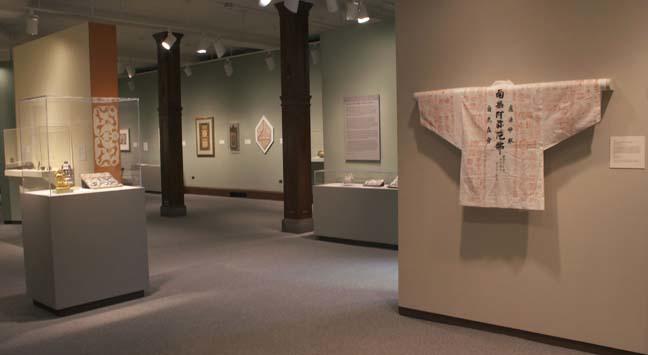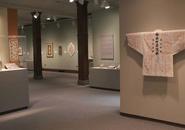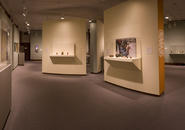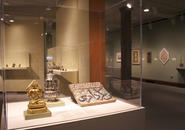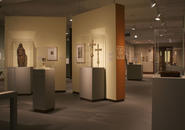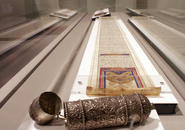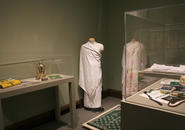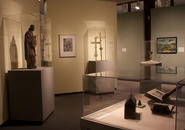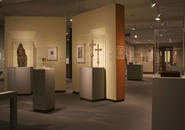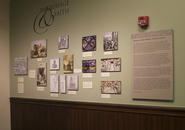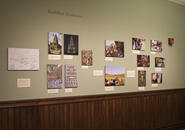Pilgrimage & Faith: Buddhism, Christianity, and Islam
Exhibit features 75 historical objects from various pilgrimages
The Iris and B. Gerald Cantor Art Gallery at the College of the Holy Cross presents Pilgrimage and Faith: Buddhism, Christianity and Islam. This exhibition, which explores pilgrimage as experienced in Buddhist, Christian and Muslim faith communities, will run from Monday, Jan. 25- Thursday, April 1, with an opening reception on Wednesday, Feb. 3 from 5 – 6:30 p.m. in the gallery. The exhibit is curated by Virginia Raguin, professor of visual arts at Holy Cross and Dina Bangdel, associate professor at art history at Virginia Commonwealth University, with input from F.E. Peters, professor emeritus of Middle Eastern and Islamic studies, history, and religion at New York University.
The exhibition will house 75 historical objects from the 12th century to the present. They include clothing worn on a present-day Muslim Pilgrimage (hajj) to Mecca; sculptures in wood and limestone from France; copper and bronze from Tibet; stained glass from the Middle Ages; a Renaissance enameled chalice from Italy; a lavish embellished Quran from Iran; and Islamic prayer scrolls in silver amulet casings. Buddhist travel in Japan is explained through a 19th-century pilgrimage itinerary book and 20th-century pilgrim's robe and staff. (As a pilgrim progressed to each of the Eighty-Eight Temples on the island of Shikoku, a stamp would be added to the robe.) Another group of objects, including a woodcut image from a 15th-century book, stained glass, and a collection of lead badges, relates to the pilgrimage to honor Thomas Becket, the murdered archbishop of Canterbury made famous by Chaucer’s Canterbury Tales.
“The global scope of the exhibit and accompanying collection of essays moves beyond an East/West opposition or the limitations of these faiths,” says Raguin. “It addresses shared goals of personal development and communal solidarity as deep human needs.”
The exhibit focuses on fundamental issues of the three religions and the many ways of convergence of practices in the pilgrimage experience. The pilgrim’s goal is the holy site and its approach involves both physical and temporal expense, beginning through detachment from the familiar. The process to, participation in and reflection on the experience can deeply alter the sense of self and of community for the believer. Paramount is the call to exercise charity to others and also, in humility, to accept charity from others. By the juxtaposition of religions in this study, whose beliefs and practices are so often seen as incompatible in a contemporary world, the collaborators hope to encourage a more nuanced understanding of shared aspirations.
The strategy of the project also focuses on the continuity of the past and the present and the motivations and experiences of persons of all social strata. It transforms our way of looking at “works of art” from these cultures, too often exhibited without their animating context. The exhibit contains objects of supreme artistic skill (Islamic glazed tile; Christian enameled reliquaries, and Buddhist bronze statues) mingled with mass-produced objects (lead pilgrimage badges, terracotta souvenirs, or paper mementos) and personal acquisitions such as stones or soil from the holy place. These objects all share the same purpose: to make more tangible the ephemeral experience and thus enable the owner to intensify memories of spiritual commitment and social interaction.
The exhibition will also travel to the Loyola University Museum of Art, Chicago; the University of Richmond, Richmond, Virginia; and the Rubin Museum of Art, New York City, before closing in October 2011.
The lenders include the Harvard University Art Museums, the Boston Public Library, The Metropolitan Museum of Art, The Newark Museum, the Loyola University Art Museum, College of the Holy Cross, Boston College, and several private collectors.
A substantial 350-page catalogue with 300 color illustrations unites 25 international experts to profile past and present practices for each religion. The three major contributors are Peters (Islam), Bangdel (Buddhism), and Raguin (Christianity).
The exhibition has been supported in part by a grant from the National Endowment of the Arts.
Gallery Events
A series of lectures and events will be held at Holy Cross in conjunction with the gallery exhibition. All events are free and open to the public.
• Wednesday, Feb. 3, 5 -6:30 p.m., Cantor Art Gallery
Opening Reception
• Thursday, Feb. 11, 4 p.m., Rehm Library, Smith Hall
Talk: The Roots and Reasons of Christian Pilgrimage, by Virginia Raguin, professor of visual arts and John E. Brooks Chair in the Humanities.
• Tuesday, Feb. 16, 12 p.m., Cantor Art Gallery
Gallery Talk: Buddhist Pilgrimage by Dina Bangdel, associate professor, Virginia Commonwealth University.
• Wednesday, Feb. 24, 4 p.m., Rehm Library, Smith Hall
Talk: Pilgrimage and Prayer in the Muslim World by Mika Natif, Andrew W. Mellon Postdoctoral Teaching Fellow in visual arts at the College.
• Tuesday, March 16, 7 p.m. Rehm Library, Smith Hall
Talk: Tolerance and Intolerance among the Monotheists: Jews, Christians, and Muslims by F. E. Peters, professor emeritus of Middle Eastern and Islamic Studies, History, and Religion at New York University.
• Tuesday, March 16, 12:30 p.m., Rehm Library, Smith Hall
Talk: Jewish and Muslim Shared Veneration of Holy Land Pilgrimage Sites by Pamela Berger, professor of art history at Boston College.
• Wednesday, March 24, 4 – 8 p.m., Cantor Art Gallery
Demonstration: Dyah tayegu, Participatory Ritual of Stupa Making by Naresh Man Bajracarya, Ph. D., Katmandu, Nepal.
• Thursday, March 25, 4 p.m., Rehm Library, Smith Hall
Talk: Buddhist Pilgrimage in the Himalayan Region by Todd Lewis, professor of religious studies at the College.
Gallery Information
Founded in 1983 through the generosity of Iris & B. Gerald Cantor, the Cantor Art Gallery serves both as a venue for a changing series of historical and contemporary public exhibitions, as well as a vital resource for Holy Cross faculty and students, linking exhibitions to the broader liberal arts curriculum.
The hours for the Cantor Art Gallery are Monday - Friday 10 a.m. - 5p.m., Saturdays 2 - 5p.m. Closed: Feb. 27 and March 6 (for Spring break). Located in O’Kane Hall, 1st Floor, College of the Holy Cross, 1 College Street, Worcester, MA, 01610. Admission to the gallery is free.
Trained student tour guides are available for individual or for groups. Group visits may be possible outside of normal Gallery hours. For additional information please call 508-793-3356 or visit the gallery’s website.


